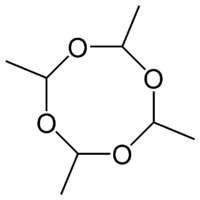- Metaldehyde
-
Metaldehyde  r-2, c-4, c-6, c-8-tetramethyl-
r-2, c-4, c-6, c-8-tetramethyl-
1,3,5,7-tetroxocaneOther names2,4,6,8-tetramethyl-1,3,5,7-
tetraoxocanemetacetaldehydeIdentifiers CAS number 108-62-3 
KEGG C18744 
Jmol-3D images Image 1 - CC1OC(C)OC(C)OC(C)O1
Properties Molecular formula C8H16O4 Molar mass 176.212 g/mol Density 1.27 g/cm³ Melting point 246°C
Boiling point sublimes at 110-120 °C
 (verify) (what is:
(verify) (what is:  /
/ ?)
?)
Except where noted otherwise, data are given for materials in their standard state (at 25 °C, 100 kPa)Infobox references Metaldehyde is an organic compound with the formula (CH3CHO)4. It is commonly used as a pesticide against slugs, snails, and other gastropods. It is the cyclic tetramer of acetaldehyde.[1]
Contents
Production and properties
Metaldehyde is obtained in moderate yields by treatment of acetaldehyde with various acid catalysts, such as hydrogen bromide. The reaction is reversible, upon heating to about 80 °C, metaldehyde reverts to acetaldehyde. Metaldehyde exists as a mixture of stereoisomers, molecules that differ with respect to the relative orientation of the methyl groups on the 8-membered ring.
Uses
As a pesticide
It is sold under various trade names as a molluscicide, including Antimilice, Ariotox, Blitzem (in Australia), Cekumeta, Deadline, Halizan, Limatox, Limeol, Meta, Metason, Mifaslug, Namekil, Slug Fest Colloidel 25, and Slugit. Typically it is applied in the form of slug pellets, which normally include a wheat bait. Metaldehyde acts on the pest by contact or ingestion, and the aqueous environment inside the pest's cells readily hydrolyzes metaldehyde into acetaldehyde, the molecule associated with an alcohol hangover.
Metaldehyde-containing baits should be used with caution as they are toxic to dogs and cats.[2]
Other uses
Metaldehyde is also used as a camping fuel. It may be purchased in a tablet form to be used in small stoves, and for preheating of Primus type stoves. It is sold under the trade name of "META" by Lonza Group of Switzerland.
Safety
Metaldehyde has a toxicity profile identical to that for acetaldehyde, being mildly toxic and irritatant to breathing at the 50 ppm level.
References
- ^ Marc Eckert, Gerald Fleischmann, Reinhard Jira, Hermann M. Bolt, Klaus Golka “Acetaldehyde” in Ullmann's Encyclopedia of Industrial Chemistry, 2006, Wiley-VCH, Weinheim. doi:10.1002/14356007.a01_031.pub2.
- ^ "Pests in Gardens and Landscapes". University of California, Davis. http://www.ipm.ucdavis.edu/PMG/PESTNOTES/pn7427.html. Retrieved 2010-08-03.
External links
- National Pesticide Information Center (NPIC) Information about pesticide-related topics.
- Get Rid of Slugs and Snails, Not Puppy Tails! Case Profile - National Pesticide Information Center
- Slugs and Snails - National Pesticide Information Center
- WHO/FAO Data sheet at inchem.org
- Solid Fuel Stoves - Metaldehyde mentioned
- Toxicology of metaldehyde
See also
- Slug controls (on Wikibooks)
Categories:- Molluscicides
- Acetals
- Oxygen heterocycles
Wikimedia Foundation. 2010.
